



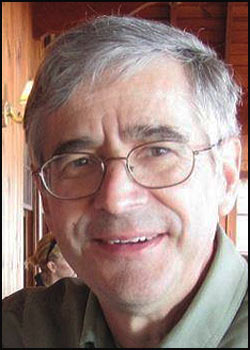
Ted was born in Michigan in 1949 and came to Wisconsin a year and a half later with his parents and two older brothers. Ted’s folks ran a grade A dairy farm a few miles southwest of Merrill. In addition to milking cows twice a day, they bottled and delivered milk to customers on two routes in the city.
Farm chores are never done and Ted grew up doing his share but his interests were not with the cattle or the machinery. Rather, Ted was fascinated by the springs and potholes in the wild pastures, the rock piles in the cultivated fields and the cool shade of the balsam, elm and maple woods. He wondered where those potholes came from and why the springs only flowed sporadically. What was the source of all those rocks and boulders in the fields and fencerows? Why did the woods always seem dark, quiet and mysterious? These and many other questions remained unanswered thru his high school years.


He spent free time wandering the fields and woods and like most farm kids, learned to hunt early and spent many a Saturday morning in the squirrel woods or chasing rabbits in the thickets.
Ted also wondered why there was always so much traffic heading north on Hwy 51 on summer weekends. His Dad said it was just “city folk” going on vacation. Farmers had serious work to do and didn’t have time for vacations. Ted knew the southern half of Lincoln County was mostly farm land with modest woodlots but north of Merrill was unknown territory. Until his college years, Ted never knew about the lakes in northern Wisconsin.
After graduating from Merrill High School in 1967, he started college at the UW Marathon County Center in nearby Wausau. He liked math and thought engineering would be a good field of study but the lure of the wild was not to be denied. After a year of struggling with advanced calculus, he happened to take a course called Limnology. That one course and the instructors, changed the direction of his life. He entered a natural world and began to find answers to his questions. That summer, he quit his job working at a local sash and door factory and took a lower paying job as an hourly helper at the UW Research Station on Trout Lake in Vilas County. He assisted UW graduate students doing research on fish, macro-invertebrates, crayfish and water quality on lakes in the Boulder Junction area. During that first summer he was introduced to streams, rivers and lakes that he never knew existed. He learned how to fish, swim, snorkel and scuba dive. He found out that Trout Lake is deep, cold and totally dark at the bottom (+100 ft). It was a whole new world and Ted spent the next three summers immersed in it.
Back at college, he changed majors and sought out natural science courses like geography, geology, botany, soils, forestry and environmental toxicology. In May 1972, he graduated with a degree in Soil Science from UW Madison. Dubious about his job prospects, he was surprised to get a call from Don Thompson in DNR’s Bureau of Research. Due to his background in fish sampling and water quality, Ted was offered an LTE position assisting Warren Churchill doing research on Lake Wingra. That was the start of a very long career and fulfilling career at Wisconsin’s Department of Natural Resources.
In the spring of 1974, Ted took a seasonal position in the Research Bureau that involved monitoring water quality on Wisconsin lakes. In spring and again in fall, Ted was part of a crew that sampled dozens of lakes throughout the state.
In the summer of 1974, he married

Rose, the love of his life.
In the summer of 1975, Ted joined the newly formed Office of Inland Lake Renewal (OILR). He was the soil scientist on a diverse team of specialists whose primary mission was to offer advice and direction to lake property owners and lake districts. Numerous lakes across the state were experiencing the negative effects of sedimentation and excess phosphorus loading. Ted’s main responsibility was to assist lake districts in assessing soil runoff from watersheds and make recommendations on corrective action. Usually this meant shoring up eroding stream and river banks. Sometimes it included in-lake dredging.
Initially, the OILR team worked out of the Pyare Square building but later were housed in what was called the “Outpost” on University Avenue.
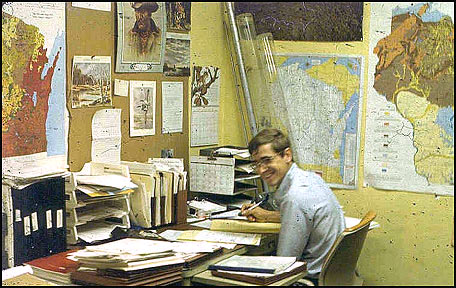
The OILR team worked with Lake Districts to conduct feasibility studies that identified problems in the lake and/or watershed. Lake renewal projects were funded primarily through state and federal grants. However, by 1979, the national economy was in a downward spiral and federal grant monies began to dry up. By the early 1980s, the state OILR program, without federal seed money, was deemed nice but not essential. A negative report from the legislative audit bureau sealed its doom and in 1983, OILR was dismantled. OILR staff were moved to other programs in the DNR that had vacancies.
Ted was offered the opportunity to step into the vacant statewide spill coordinator position. Friends in the agency advised that this might not be a good fit for someone who was soft spoken and highly analytical. However, the job options were limited so in March 1983, Ted took the plunge. His first trial by fire came within a few weeks of taking this new position. A bulk plant in Dodge County spilled several thousand gallons of diesel at their facility. Much of the fuel ran off site and into the adjacent Rock River. Working with spillers and getting them to respond appropriately and cleanup as necessary was new territory for Ted. Plus, he couldn’t be in two places at the same time so he soon learned to rely on agency field staff in water quality, solid and hazardous waste and especially law enforcement for advice and assistance.
The Hazardous Substance Spills Program was high profile and occasionally controversial but along with considerable responsibility came some perks. For example, in 1984 Ted and several volunteer spill staff in the districts were authorized to attend the National Spill Response Conference in Nashville, Tennessee.
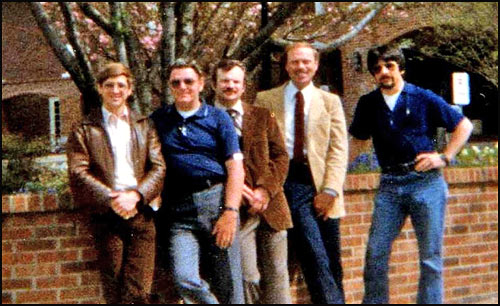
Since some members of this spill team were scheduled to make presentations at the conference, they were able to travel to and from Nashville using the Governors plane. Wisconsin’s Spill Law was wide reaching and every year brought new scenarios and challenges. In June, 1984, a major tornado destroyed most everything in the village of Barneveld except the water tower.
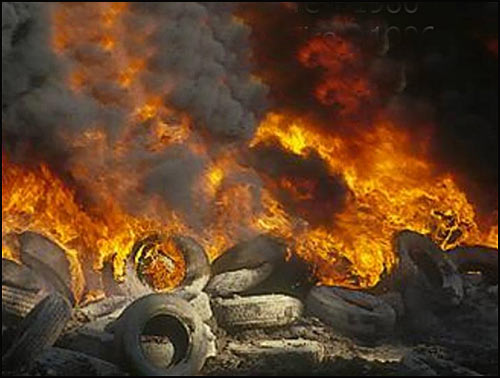
A few years later it was another tornado in the town of Oregon, Dane County
In 1987, Ted was promoted to the position of Spills and Leaking Underground Storage Tanks (LUST) Unit Leader. In addition to overseeing DNR’s statewide spill response efforts, he took on the responsibility to develop a cooperative agreement with US EPA on implementing a federally funded state run leaking underground storage tank program. Further, he was tasked with overseeing DNR use of federal LUST Trust funds and coordinating the development of a state corrective action program for leaking underground storage tanks.
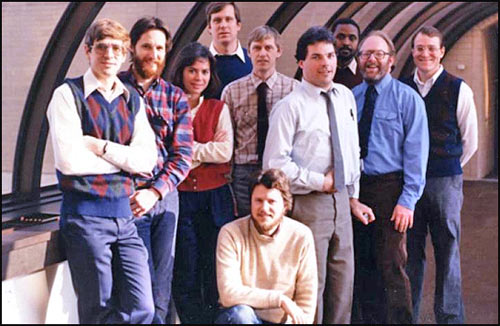
While this work was critical to the development and implementation of Wisconsin’s LUST program, it took Ted farther and farther from the field. The endless meetings and haranguing over policy, procedures and rules took a toll and tied Ted to his desk and the office more than he liked.
A year later, he transferred to the spill coordinator position in Southern District. There he served as the DNR's South Central Regional expert on all spill response and abandoned container activities. His primary duties were environmental protection and public safety. This put him back in the field when spills occurred and on the front line where assessments and decisions had to be made quickly. With his years of experience at the statewide level, Ted was able to quickly adjust to sitting in the “hotseat” in Southern District; and the heat came quickly and often.
In 1991, a butter fire on Madison’s east side took up Ted’s time from May to mid-summer.
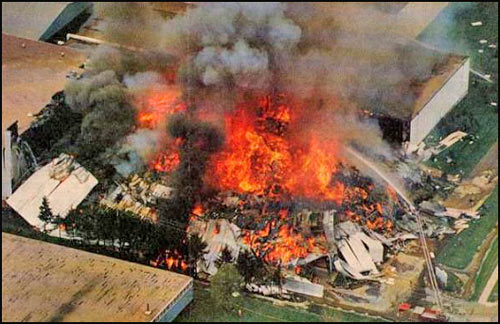
In 1992, a large slurrystore leaked 500,000 gallons of liquid manure in Green County. The manure flowed downhill where it soon joined a small stream. The manure continued flowing for another three miles before emptying into a trout stream. Efforts to block the river of manure with gravel dikes and small retention ponds along the way were marginally successful.

As the regional spill coordinator from the late 1980s until 2008, Ted responded to all kinds of hazardous substance spills and abandoned containers. It was challenging and a bit unnerving because you never knew what tomorrow would bring. Despite the uncertainty, it was important work and provided a unique opportunity to protect the valuable resources of the state and make a difference every day.
In January 2008, after 25 years in the Spills Program and nearly 36 years with DNR, Ted retired.
However, his interest in spills and emergency response was undiminished. Barely three months after his official retirement, he returned to DNR as an LTE. From March 2008 to March 2018, Ted served as the spills data LTE, reviewed historical spills for closure and filled in as acting regional spill coordinator as needed.
In the fall of 2008, he switched programs for a month while he worked as DNR’s project manager overseeing Living Lands and Waters, a river cleanup contractor.

LLW was hired to remove the housing debris that washed into the Wisconsin River when Lake Delton washed out during the floods in June.
On St Patrick’s Day in 2018, Ted retired from DNR the second (and final?) time.
In his early years (between college and children) Ted enjoyed deer hunting with gun and bow, small game hunting, scuba diving, swimming, fishing, hiking and wood cutting. When time permitted, Ted enjoyed distance running and competed in numerous road races in the Madison area. After a couple of marathons in his mid-30s, Ted’s training and racing time tailed off as his three sons and daughter came of age.

From that point on, Ted's activities became more family oriented. Visiting state and national parks, alpine hiking, soccer games and swim meets dominated his free time. He preferred to keep active even as a spectator so at swim meets, he was a timer and at soccer tournaments, he was either coaching or officiating as a referee.

His love of the outdoors and of the land never faded. In 1988, after years of searching for their own piece of land, Ted and Rose bought 20 acres of woods in Vilas County – a Northwoods retreat. Eighteen months later, he built a cabin that doubled as a garage.

That served as his hunting and fishing base for the next 20s years. Whenever he needed quiet time, he returned to the Northwoods. Eventually, certain family members requested more modern accommodations. Ted had always dreamed of owning a lake home but doubted that would ever come to pass. However, his first retirement and ensuing LTE position came at an unusual time. A perfect storm of a depressed economy, plummeting real estate values and his rising income led him to begin looking. Late in 2009, he found a charming house with acreage on Lower Sugarbush Lake in Western Vilas County. A month later, he and Rose were proud owners of their own lake home.

Ted enjoys fishing and gets out in search of walleyes each summer and is frequently joined by his sons. His favorite lakes are Trout (of course) along with Fence and the Turtle-Flambeau Flowage.

A few years later, his second son (Mike) who was now a forester, suggested they tap some of the sugar maples at the Lake Home. The rest, as they say, is history. Ted and son and friends now tap +100 trees and make 25-30 gallons of fine maple syrup every spring. After a couple of years of cooking in the snow, sleet, rain and wind of a typical spring, Ted decided to build a “sugar shack”. He started with a basic post-n-beam structure that resembled a park shelter. Then he filled in the walls with cordwood set in a sand, lime and sawdust mortar mixture. The end result was an 18x24 cordwood sugar house completed in the summer of 2016. The twelve inch thick walls are made of white cedar with occasional wine bottles inserted for color.
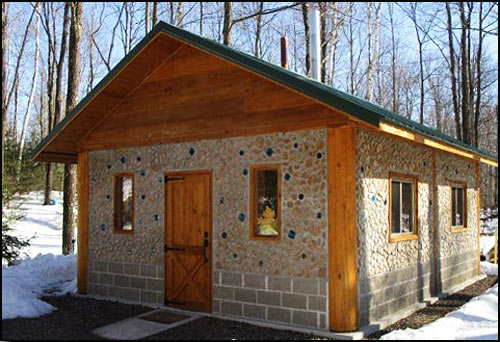
The sons have now grown up but they return each November to join Ted on the annual deer gun hunt in northern Bayfield County.
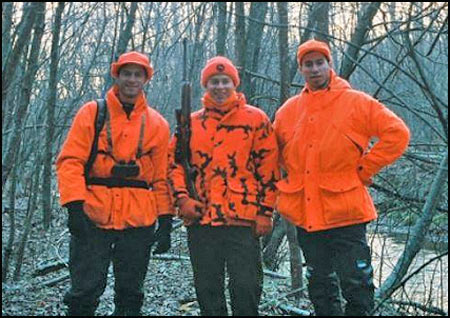
Ted has a passion for journaling and started keeping a daily journal in 1975. In addition, he writes summaries of special outings and events such as – November deer hunting, May turkey hunting, June walleye fishing, summer mountain climbing and spring maple syrup efforts. He has a written summary of each of his deer hunts, starting in 1964 and continuing up to the present. If opportunity presents, he hopes to eventually turn it into a book.

Ted was fortunate to find a career that paralleled his interests in the outdoors. In his retirement, he continues to find ways to observe and enjoy the valuable natural resources of Wisconsin